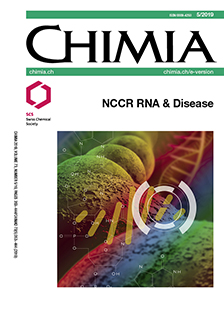Structural Transition, Function and Dysfunction of TDP-43 in Neurodegenerative Diseases
DOI:
https://doi.org/10.2533/chimia.2019.380PMID:
31118120Keywords:
Als, Ftd, Neurodegenerative diseases, Protein misfolding, Protein aggregation, Rna metabolism, Tdp-43, Tdp-43 proteinopathiesAbstract
Altered cellular localization and pathologic aggregation of RNA binding proteins (RPBs) containing low complexity regions (LCRs) is a hallmark of neurodegenerative diseases such as amyotrophic lateral sclerosis (ALS) and frontotemporal dementia (FTD). Given the importance of RBPs in maintaining a healthy RNA homeostasis, a common mechanism in disease progression is the loss of RNA-related cellular functions. In this review, we summarize and discuss the knowledge gained in the recent years on the molecular mechanisms of TDP-43 proteinopathies that comprise a set of neurodegenerative diseases characterized by the mislocalization and aggregation of the RNA-binding protein TDP-43. Based on biophysical, biochemical and in vivo data, we highlight pathways that are misregulated early in disease and contribute to its progression, thereby representing attractive therapeutic targets.Downloads
Published
2019-05-29
How to Cite
[1]
T. Afroz, M. Pérez-Berlanga, M. Polymenidou, Chimia 2019, 73, 380, DOI: 10.2533/chimia.2019.380.
Issue
Section
Scientific Articles
License
Copyright (c) 2019 Swiss Chemical Society

This work is licensed under a Creative Commons Attribution-NonCommercial 4.0 International License.







